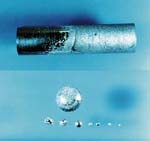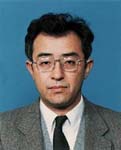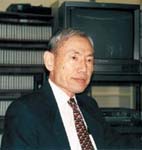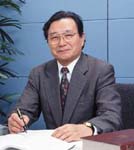 |
Space Utilization Research Program |
 |
 |
Introduction to Major Research Themes
SURP's ground-based research as initiative and common basic research |
|
 |
 |
Research Team Leader:
Kyoichi Kinoshita
(NTT Basic Research Laboratories, Senior Research Scientist, Supervisor) |
Pb1-xSnxTe
Crystals Grown in the FMPT Mission aboard the Space Shuttle "Endeavour" |
The InxGa1-xAs ternary mixed crystal is very promising
in the field of optical communications. In this study, we attempt to prove
the advantage of microgravity by manufacturing uniform, single crystals
of In0.3Ga0.7As which have never been grown on the
ground suck crystals expected to be substrates of 1.3 micro m wavelength
laser diodes. This space experiment seeks to grow crystals free from perturbations
which exist even in microgravity. Crystals will be grown from a feed in
which the concentration gradient offsets the effect of convection due to
residual accelerations in microgravity. |
 |
Research Team Leader:
Toshio Itami
(Hokkaido University,
Assistant Professor) |
In molten materials, the existence of chemical order is presumed. The diffusion
behavior seems to be influenced deeply by this chemical order. Recently,
much attention has been focused on the melts of metals, alloys and semiconductors
because these melts are regarded as complex liquids with chemical or particular
order rather than simple liquids with a random assembly of atoms. In this
research project the diffusion mechanism will be studied, using accurate
diffusion with particular interest on its relation to liquid structures. |
|
|
 |
 |
Research Team Leader:
Shinichi Yoda
(NASDA, Senior Engineer) |
Lead Scientist:
Yasuhiro Kamotani
(Case Western Reserve University, Professor) |
Marangoni convection is the main factor causing flow in under microgravity.
Thus, Marangoni convection experiments have been conducted relatively often
in the fluid field, with both steady and oscillating flows clarified. So
far, steady state Marangoni has been clarified, but the transition from
the steady state to the oscillating state and the mechanism of oscillating
flow are not yet fully understood. In this study, we will try to construct
a model focusing on transformation of a free surface; verify this model
by experimental, numerical, and theoretical methods; and clarify the Marangoni
Convection phenomenon.
*Marangoni convection is the flow due to the surface tension
(liquid-to-liquid, or liquid-to-gas) difference which is generated by a
temperature or concentration gradient. It is difficult to observe this
phenomenon on the ground due to thermal convection, but it becomes the
main factor affecting flow in microgravity. |
 |
 |
Research Team Leader:
Atsushige Sato
(Tokyo Medical & Dental University, Professor Emeritus)
(SURP Advisor) |
Mouse osteoblast - derived
MC3T3-E1 cell culture. |
Restriction of bone formation in microgravity has been observed, but its
mechanism at the cellular level or molecular level is not thoroughly understood.
In this study, we will investigate secondary signals produced in the cell
through simulated microgravity and high gravity on the osteoblast, whose
role is the formation of bone, and further survey the gene expression by
the molecular biology method. The results will contribute not only to bone
biology, but also to the remedy and prevention of osteoporosis, a disease
from which astronauts and older people suffer. |
| Last Updated : December 17, 1999 |
|
